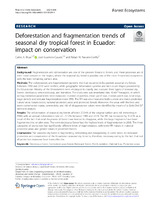Mostrar el registro sencillo del ítem
Deforestation and fragmentation trends of seasonal dry tropical forest in Ecuador: impact on conservation
| dc.contributor.author | Rivas Cobo, Carlos Alfredo | |
| dc.contributor.author | Guerrero Casado, José | |
| dc.contributor.author | Navarro Cerrillo, Rafael M. | |
| dc.date.accessioned | 2024-02-01T19:27:36Z | |
| dc.date.available | 2024-02-01T19:27:36Z | |
| dc.date.issued | 2021 | |
| dc.identifier.issn | 2197-5620 | |
| dc.identifier.uri | http://hdl.handle.net/10396/26961 | |
| dc.description.abstract | Background: Fragmentation and deforestation are one of the greatest threats to forests, and these processes are of even more concern in the tropics, where the seasonal dry forest is possibly one of the most threatened ecosystems with the least remaining surface area. Methods: The deforestation and fragmentation patterns that had occurred in Ecuadorian seasonal dry forests between 1990 and 2018 were verified, while geographic information systems and land cover shapes provided by the Ecuadorian Ministry of the Environment were employed to classify and evaluate three types of seasonal dry forests: deciduous, semi-deciduous, and transition. The study area was tessellated into 10 km2 hexagons, in which six fragmentation parameters were measured: number of patches, mean patch size, median patch size, total edge, edge density and reticular fragmentation index (RFI). The RFI was also measured both outside and inside protected natural areas (unprotected, national protected areas and protected forest). Moreover, the areas with the best and worst conservation status, connectivity and risk of disappearance values were identified by means of a Getis-Ord Gi * statistical analysis. Results: The deforestation of seasonal dry forests affected 27.04% of the original surface area still remaining in 1990, with an annual deforestation rate of -1.12% between 1990 and 2018. The RFI has increased by 11.61% as a result of the fact that small fragments of forest have tended to disappear, while the large fragments have been fragmented into smaller ones. The semi-deciduous forest had the highest levels of fragmentation in 2018. The three categories of protection had significantly different levels of fragmentation, with lower RFI values in national protected areas and greater values in protected forests. Conclusions: The seasonal dry forest is fragmenting, deforesting and disappearing in some areas. An increased protection and conservation of the Ecuadorian seasonal dry forest is, therefore, necessary owing to the fact that not all protection measures have been effective. | es_ES |
| dc.format.mimetype | application/pdf | es_ES |
| dc.language.iso | eng | es_ES |
| dc.publisher | Springer | es_ES |
| dc.rights | https://creativecommons.org/licenses/by/4.0/ | es_ES |
| dc.source | Rivas Cobo, A., Guerrero-Casado, J., & Navarro-Cerillo, R. M. (2021). Deforestation and Fragmentation Trends of seasonal dry tropical forest in Ecuador: Impact on conservation. Forest Ecosystems, 8(1). https://doi.org/10.1186/s40663-021-00329-5 | es_ES |
| dc.subject | Deciduous forest | es_ES |
| dc.subject | Semi-deciduous forest | es_ES |
| dc.subject | Remmant forest | es_ES |
| dc.subject | Patch isolation | es_ES |
| dc.subject | Habitat loss | es_ES |
| dc.subject | Protected areas | es_ES |
| dc.title | Deforestation and fragmentation trends of seasonal dry tropical forest in Ecuador: impact on conservation | es_ES |
| dc.type | info:eu-repo/semantics/article | es_ES |
| dc.relation.publisherversion | https://doi.org/10.1186/s40663-021-00329-5 | es_ES |
| dc.relation.projectID | Junta de Andalucía. 1264483-R | es_ES |
| dc.relation.projectID | Junta de Andalucía. UCO-1265298 | es_ES |
| dc.relation.projectID | Gobierno de España. CGL2017–86161-R | es_ES |
| dc.rights.accessRights | info:eu-repo/semantics/openAccess | es_ES |

